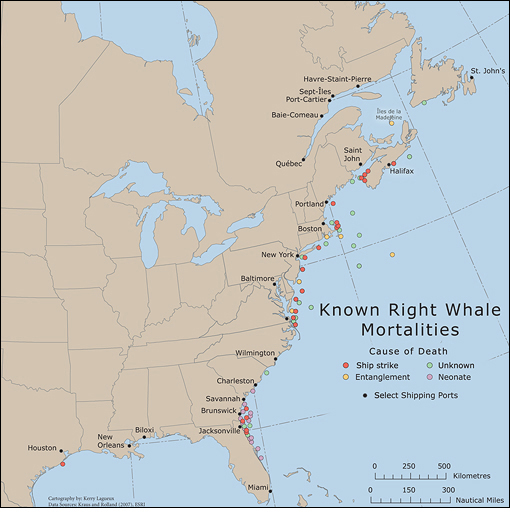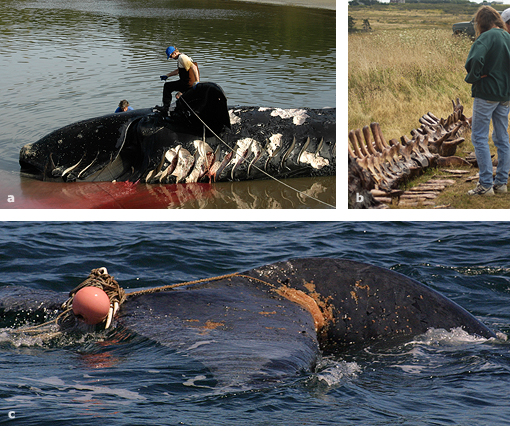


Rates and causes of mortality for North Atlantic right whales have been determined using information from necropsies and photographic data 1, 2, 3, 4. As with other mammals, the mortality rate is higher in newborns and juveniles than in adults. In right whales, mortality ranges from 24 percent for the calf’s first year to 5 percent for its third year 5. As the animal gets older, between the ages of 4 and 10, the mortality rate drops to between 1 and 3 percent annually.
Most adult right whales have no known predators. This is not the case with younger individuals, for example it is known that killer whales can prey on young right whales, although the number might not be significant due to the small size of the western Atlantic killer whale population. It is also possible that some sharks could feed on young right whales although evidence of that has only been seen on carcasses and may have occurred after death.

Known right whale mortalities and cause of death along the coast of Canada and the United States.
It is well known that a significant number of North Atlantic right whale deaths are related to human activities 6, the two main causes being vessel strikes and entanglement in fixed fishing gear 7. Analyses of documented right whale deaths between 1986 and 2005 show that 38 percent of mortalities were a result of vessel strikes, 12 percent were due to entanglement in fishing gear and the remaining 50 percent were attributed to unknown causes or neonatal mortality 8. Some researchers believe the higher observed mortality rate of adult females over adult males plays a major role in the current population decline and that preventing the death of two females every year could reverse that trend 9. Along the eastern seaboard, breeding females have a long migration between feeding and calving areas through highly industrialized waters. Their near shore migration pattern potentially increases the possibility of vessel strikes and entanglement than that for other segments of the right whale population. One particularly sobering example of right whale mortality occurred between February 2004 and April 2005 when eight dead right whales were reported. Vessel strikes were responsible for three of the deaths and one was due to entanglement in fishing gear. Six of the whales were adult females: three were pregnant at the time of their death 10.

a) Right whale #3508 was found dead off the coast of Florida on New Years Eve in 2006. The cause of death was attributed to a vessel strike. The parallel marks on the whale are propeller cuts. b) After a necropsy of a right whale carcass at Kelly’s Cove near Yarmouth, Nova Scotia in 2006, the skeleton showed signs of a major blunt trauma due to a vessel collision, 17 of the vertebrae showed fractures; the fragments are lying on the ground. c) Right whale #3107 was seen with wraps of line around the tail stock in 2002. Although some individuals will free themselves from rope, others can carry fishing gear for years. Unfortunately, #3107 did not free herself and died later that year.

1, 6 Kraus, S. D. 1990. Rates and potential causes of mortality in North Atlantic right whales (Eubalaena glacialis). Marine Mammal Science 6:278-291.
2 Kenney, R. D., and S. D. Kraus. 1993. Right whale mortality - a correction and an update. Marine Mammal Science 9:445-446.
3 Knowlton, A. R., and S. D. Kraus. 2001. Mortality and serious injury of northern right whales (Eubalaena glacialis) in the western North Atlantic Ocean. Journal of Cetacean Research and Management Special Issue 2:193-208.
4, 7 Moore, M., A. Knowlton, S. Kraus, W. McLellan, and R. Bonde. 2005. Morphometry, gross morphology and available histopathology in Northwest Atlantic right whale (Eubalaena glacialis) mortalities (1970-2002). Journal of Cetacean Research and Management 6:199-214.
5 Kraus, S. D. 2002. Birth, death and taxis: North Atlantic right whales in the twenty-first century. Ph.D. Thesis. University of New Hampshire, Durham.
8, 10 Kraus, S. D., M. W. Brown, H. Caswell, C. W. Clark, M. Fujiwara, P. K. Hamilton, R. D. Kenney, A. R. Knowlton, S. Landry, C. A. Mayo, W. A. McLellan, M. J. Moore, D. P. Nowacek, D. A. Pabst, A. J. Read, and R. M. Rolland. 2005. North Atlantic right whale in crisis. Science 309:561-562.
9 Fujiwara, M., and H. Caswell. 2001. Demography of the endangered North Atlantic right whale. Nature 414:537-541.

